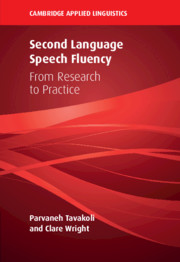Book contents
- Second Language Speech Fluency
- The Cambridge Applied Linguistics Series
- Second Language Speech Fluency
- Copyright page
- Dedication
- Contents
- Figures
- Tables
- 1 Introduction
- 2 Fluency from a Psycholinguistic Perspective
- 3 Measuring Fluency
- 4 Fluency in Second Language Task-Based Research
- 5 Fluency in Second Language Pedagogy
- 6 Fluency in Second Language Testing
- 7 Fluency in Different Contexts
- 8 Conclusion
- Appendix: Fluency Descriptors across Time
- References
- Author Index
- Subject Index
8 - Conclusion
Published online by Cambridge University Press: 15 December 2020
- Second Language Speech Fluency
- The Cambridge Applied Linguistics Series
- Second Language Speech Fluency
- Copyright page
- Dedication
- Contents
- Figures
- Tables
- 1 Introduction
- 2 Fluency from a Psycholinguistic Perspective
- 3 Measuring Fluency
- 4 Fluency in Second Language Task-Based Research
- 5 Fluency in Second Language Pedagogy
- 6 Fluency in Second Language Testing
- 7 Fluency in Different Contexts
- 8 Conclusion
- Appendix: Fluency Descriptors across Time
- References
- Author Index
- Subject Index
Summary
The chapter summarises the main arguments and evidence throughout the volume, presenting the case for a broad multidisciplinary perspective on defining, understanding and researching L2 fluency by considering fluency as a dynamic variable in language performance that interacts with cognitive factors as well as with external factors.Main points from research and practice are synthesised evaluating current insights into fluency across cognitive, interactional, pedagogic and assessment domains. We finish by identifying remaining gaps in our understanding of how fluency develops, and how combining research and practice is needed to help understand issues of real-life second language communication.
- Type
- Chapter
- Information
- Second Language Speech FluencyFrom Research to Practice, pp. 146 - 157Publisher: Cambridge University PressPrint publication year: 2020

